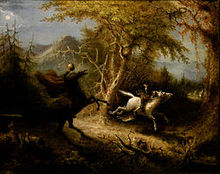John Quidor
| John Quidor | |
|---|---|

The Headless Horseman Pursuing Ichabod Crane (1858)
|
|
| Born |
January 26, 1801 Tappan, New York |
| Died | December 14, 1881 (aged 80) Jersey City, New Jersey |
| Nationality | American |
| Education | John Wesley Jarvis |
| Known for | Painting, History painting |
| Notable work |
Dorothea (1823) The Headless Horseman Pursuing Ichabod Crane (1858) The Money Diggers (1832) Leatherstocking's Rescue (q.v.) |
John Quidor (January 26, 1801 – December 13, 1881) was an American painter of historical and literary subjects. He has about 35 known canvases, most of which are based on Washington Irving's stories about Dutch New York, drawing inspiration from the Hudson Valley and from such English painters as William Hogarth, Isaac Cruikshank, James Gillray, Joseph Wright of Derby, and George Morland.
John Quidor was born in 1801 in Tappan, New York. His family moved to New York City in 1810. In 1818, at the age 17, he began an apprenticeship with John Wesley Jarvis (where artist Henry Inman was also training), which was the only artistic training he received. The apprenticeship was not a success. Quidor felt that Jarvis did not pay sufficient attention to him, favoring Inman over him, leading Quidor in 1822 to sue Jarvis for breach of indenture, winning damages of $251.35. Because he had to admit that he had received inadequate training, the lawsuit damaged his reputation more than Jarvis'.
Following his apprenticeship, Quidor earned a living by painting banners and doing decorative work on steamboats and fire engines for New York's fire companies. None of his decorative work is known to have survived. Starting in the mid-1820s, he began creating paintings based on literary themes, including Washington Irving's short stories Legend of Sleepy Hollow and Rip Van Winkle and James Fenimore Cooper's book The Pioneers. During this part of his career, he took on Thomas Bangs Thorpe and Charles Loring Elliott as his apprentices. Of his time working for Quidor, Thorpe recalled that "in all the time we were with Quidor, many months, I do not remember of his giving us anything but easel room and one or two very common engravings to copy. He would absent himself from his studio for days and weeks together. When present, if not painting on a banner or engine back, he would generally lie at full length on the long bench."
...
Wikipedia
